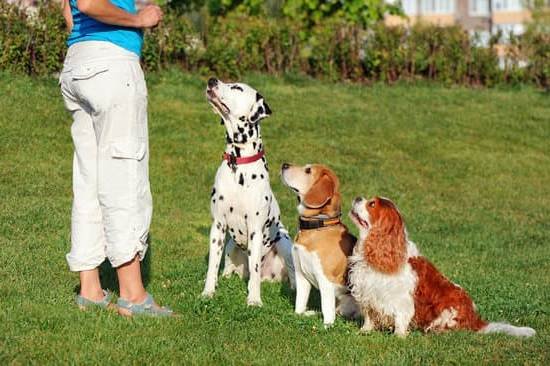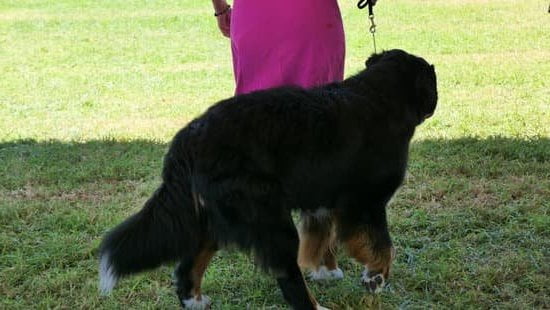Dog training hand signals are a powerful tool for effective communication with your canine companion. Unlike verbal cues, using hand signals allows you to convey commands to your dog from a distance, in noisy environments, or even when they are unable to hear you. In this article, we will explore the basics of how dog training hand signals work and discuss the benefits of incorporating them into your training routine.
Understanding the basics of dog training hand signals is essential for successfully implementing them in your training efforts. By utilizing visual cues, you can establish clear communication with your dog and facilitate quicker and more reliable responses to commands. Whether you are teaching basic obedience or advanced tricks, hand signals can significantly enhance your ability to communicate with your furry friend.
One of the key benefits of using hand signals in dog training is their versatility. They can be especially useful for dogs who have hearing impairments or those that are easily distracted by environmental noises.
Additionally, incorporating hand signals can strengthen the bond between you and your pet by promoting focus and engagement during training sessions. Throughout this article, we will delve into the different types of dog training hand signals and provide a step-by-step guide on how to teach them to your canine companion.
Understanding the Basics
Visual Communication
Using hand signals in dog training relies on visual communication. Dogs are highly observant animals and can easily pick up on body language and hand movements. Hand signals provide a non-verbal way to communicate with your dog, making it easier for them to understand what you want them to do without relying solely on vocal commands.
Association and Repetition
When using hand signals in dog training, it’s important to associate each signal with a specific command or behavior. For example, a closed fist may signal “sit” while an open palm may signal “stay.” Consistency is key when associating these signals with commands, as repetition will help your dog learn and respond to the signals more effectively over time.
Physical Cue Reinforcement
Incorporating hand signals into your dog training routine also reinforces the physical cues that accompany verbal commands. For instance, when teaching your dog to sit, the hand signal for “sit” can be paired with the physical action of gently guiding your dog into a sitting position. This reinforcement strengthens your dog’s understanding of the desired behavior and can lead to faster and more reliable responses.
By understanding how dog training hand signals work through visual communication, association and repetition, and physical cue reinforcement, you can effectively incorporate this method into your training routine and enhance your communication with your canine companion.
Benefits of Using Hand Signals in Dog Training
Dog training hand signals offer numerous benefits when it comes to training your furry companion. These visual cues can be a valuable addition to verbal commands, especially for dogs that are hard of hearing or in noisy environments. Here are some of the key benefits of using hand signals in dog training:
- Improved Communication: Incorporating hand signals into your dog training routine can help improve communication between you and your pet. Dogs are highly visual animals, and they often respond well to visual cues. By using hand signals along with verbal commands, you can reinforce your messages and make it easier for your dog to understand what you’re asking of them.
- Distance Control: Hand signals allow you to communicate with your dog from a distance. This can be particularly useful in situations where verbal commands may not be heard, such as at the dog park or during off-leash activities. With effective hand signals, you can maintain control over your dog’s behavior from afar.
- Universal Understanding: Unlike verbal commands, which may vary in tone and accent, hand signals provide a universal form of communication that transcends language barriers. This is especially beneficial for households with multiple family members or in multi-dog environments, as everyone can use the same set of hand signals to convey commands to the dogs.
By understanding these benefits and incorporating them into your training routine, you can take advantage of the power of dog training hand signals to enhance the bond and communication between you and your canine companion.
Different Types of Dog Training Hand Signals
When it comes to training your dog, using hand signals can be a powerful tool to communicate commands effectively. There are various types of hand signals that you can use to train your dog, and each type serves a specific purpose in conveying instructions without the need for verbal communication.
One type of hand signal is the directional hand signal, which involves using hand movements to guide your dog in a specific direction. For example, if you want your dog to move left or right, you can use a sweeping motion with your hand to indicate the desired direction. Another type is the stop signal, which typically involves raising your palm towards your dog to signify that they should halt their current action.
Additionally, there are also hand signals for specific commands such as sit, stay, come, and lie down. Each command has its corresponding hand gesture that helps your dog understand what action you want them to perform. Consistency and clarity in using these signals are key in ensuring that your dog comprehends and responds appropriately to the commands.
Moreover, some advanced hand signals involve combining multiple gestures or incorporating body language into the cues for more complex commands. These signals require more practice and precision but can be incredibly useful in enhancing communication between you and your dog during training sessions.
| Type of Hand Signal | Description |
|---|---|
| Directional Hand Signal | Using sweeping motion with hand to guide the dog’s direction |
| Stop Signal | Raising palm towards the dog to signify halting current action |
| Specific Command Signal | Gestures for sit, stay, come, lie down commands to convey instructions effectively |
How to Teach Your Dog Hand Signals
Teaching your dog hand signals can be a fun and effective way to communicate with your furry friend. Using these visual cues can help reinforce verbal commands and provide a clear form of communication, especially for dogs with hearing impairments. In this step-by-step guide, we will cover the basics of how to teach your dog hand signals.
The first step in teaching your dog hand signals is to choose the signals you want to use for each command. It’s important to select simple, distinct gestures that are easy for your dog to see and understand. For example, a closed fist might be the signal for “sit,” while an open palm facing upward could indicate “stay”.
Once you have chosen your hand signals, it’s time to start training. Begin by pairing each hand signal with its corresponding verbal command. For example, every time you give the “sit” command, make sure to show the hand signal at the same time. This association will help your dog understand the meaning of each gesture.
Consistency is key when teaching hand signals to your dog. Make sure to use the same gestures every time you give a command, and always follow up with praise or rewards when your dog responds correctly. With patience and practice, you’ll soon find that your dog is responding reliably to both verbal commands and their accompanying hand signals.
| Benefits of Dog Training Hand Signals | Data |
|---|---|
| Enhances communication between owner and dog | Clear visual cues help dogs understand commands |
| Provides an alternative form of communication for dogs with hearing impairments | Helps reinforce verbal commands by adding a visual component |
| Can be useful in noisy environments where verbal commands may not be heard | Aids in obedience training by providing consistent cues |
Common Mistakes to Avoid When Using Hand Signals in Dog Training
Not Being Consistent
One of the most common mistakes that dog owners make when using hand signals in training is not being consistent with their signals. Dogs rely heavily on consistency and repetition to understand commands, so using different hand signals for the same command can confuse them.
For example, if you use a closed fist for “sit” one day and then point downwards the next, your dog may struggle to understand what you’re asking of them. It’s important to choose a set of hand signals for each command and stick with them consistently.
Using Ambiguous or Confusing Signals
Another mistake that dog owners often make is using ambiguous or confusing hand signals during training. Hand signals should be clear, distinct, and easy for your dog to recognize from a distance. Avoid using overly complicated gestures or movements that may be unclear to your dog. Similarly, avoid using the same hand signal for multiple commands, as this can lead to confusion.
Expecting Instant Results
Some dog owners make the mistake of expecting their dogs to immediately understand and respond to hand signals without giving them enough time to learn and practice. Just like verbal commands, hand signals require patience and consistent training. It’s important to give your dog ample time to associate each hand signal with its corresponding command, and to practice regularly until they become second nature.
By avoiding these common mistakes in using dog training hand signals, you can help ensure that your furry friend learns effectively and efficiently.
Advanced Hand Signals for More Complex Commands
Once your dog has mastered the basic hand signals, you can move on to more advanced commands. These advanced hand signals can help you communicate more complex instructions to your furry friend and further strengthen the bond between you.
Here are some advanced hand signals that you can teach your dog:
- Distance Down: This signal involves pointing downwards with your arm extended. It is a useful command when you need your dog to lie down at a distance, such as in dog sports or obedience competitions.
- Quiet/Silence: For this signal, place a finger over your mouth or press it against your lips. This teaches your dog to stop barking or to remain silent.
- Stay: Extend an open palm towards your dog while giving the verbal command “stay”. This signal helps reinforce the verbal cue and encourages your dog to remain in place until released.
Teaching these advanced hand signals requires patience and consistency. It’s important to gradually introduce these commands and practice them regularly with positive reinforcement. Remember that every dog learns at their own pace, so be patient if it takes time for your furry companion to understand and respond to these advanced signals.
Advanced hand signals for more complex commands can add a new level of communication between you and your dog. When used correctly, they can also enhance off-leash control and improve overall obedience.
Just like with the basic hand signals, it is crucial to always pair these commands with positive reinforcement and consistency during training sessions. By incorporating advanced hand signals into your training routine, you continue to build a strong foundation of communication with your canine companion that will benefit both of you in various situations.
Tips for Mastering Dog Training Hand Signals
When it comes to mastering dog training hand signals, there are a few dos and don’ts to keep in mind to ensure effective communication with your furry friend.
Firstly, one of the most important dos is to be consistent. Consistency is key when using hand signals in dog training. Make sure to use the same signal for the same command every time, and avoid using conflicting signals for different behaviors. This will help your dog understand and respond to the signals more effectively.
Another important dos is to practice patience. Just like any form of training, mastering dog training hand signals takes time and patience. Dogs may not always pick up on the signals immediately, so it’s important to be patient and give them the time they need to learn and understand the signals.
On the other hand, when it comes to the don’ts of mastering dog training hand signals, one important thing to avoid is using harsh or aggressive gestures. Hand signals should be clear, gentle, and positive in order to maintain a positive training environment for your dog. Avoid using forceful or intimidating gestures that can cause confusion or fear in your pet.
In addition, it’s also important not to rely solely on hand signals without verbal cues. While hand signals are a powerful tool in dog training, it’s essential to combine them with verbal commands as well. This dual approach provides a comprehensive communication system that your dog can easily understand and respond to. By following these dos and don’ts, you can effectively master dog training hand signals and strengthen the bond with your canine companion.
Conclusion
In conclusion, dog training hand signals are an invaluable tool for effectively communicating with and training our canine companions. The use of hand signals in conjunction with verbal commands can greatly enhance the obedience and responsiveness of dogs, making training more efficient and successful. By understanding the basics of how dog training hand signals work and the benefits they offer, dog owners can take their training to a whole new level and develop a deeper bond with their furry friends.
One of the key benefits of using hand signals in dog training is the ability to communicate with our pets in a way that transcends language barriers. Dogs are highly visual animals, and they often respond more readily to visual cues than to verbal commands alone. Incorporating hand signals into training allows for clear and precise communication, leading to quicker learning and better retention of commands by our canine companions.
Moreover, teaching your dog hand signals can also be a fun and rewarding experience for both the pet and the owner. It provides an opportunity for increased interaction, trust-building, and mental stimulation for the dog.
As with any form of training, consistency, patience, and positive reinforcement are crucial when incorporating hand signals into your dog’s obedience regimen. With careful practice and dedication, mastering dog training hand signals can lead to a harmonious relationship between you and your beloved pet.
Frequently Asked Questions
Are There Standard Hand Signals for Dog Training?
Yes, there are standard hand signals for dog training. These visual cues can be used in conjunction with verbal commands to help dogs understand what is expected of them. They are especially useful for deaf or hearing-impaired dogs.
What Are the 7 Most Important Dog Commands?
The 7 most important dog commands are: sit, stay, come, down, heel, leave it, and off. These commands are essential for communicating with and controlling a dog in various situations, from walks to social interactions.
What Is the Hand Signal for Speak Dog?
The hand signal for “speak” in dog training typically involves raising a closed fist to the dog’s nose and then opening it as if releasing something. This gesture is usually paired with the verbal command “speak” and can be an effective way to teach a dog to bark on cue.

Welcome to the blog! I am a professional dog trainer and have been working with dogs for many years. In this blog, I will be discussing various topics related to dog training, including tips, tricks, and advice. I hope you find this information helpful and informative. Thanks for reading!





